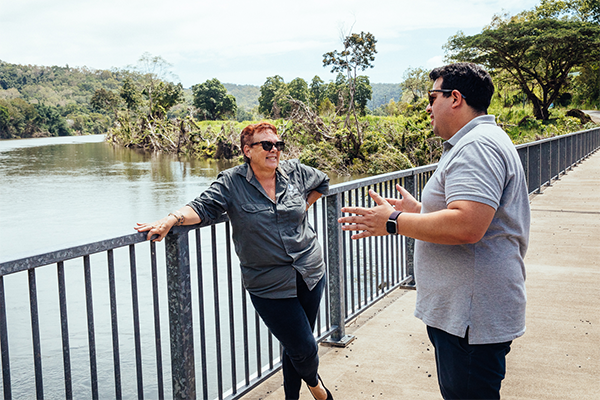
L-R: Wujal Wujal CEO Kylie Hanslow, LGAQ Disaster Management Lead Liz Drumm, Cook Shire Council Disaster Management Officer Narelle Dukes and LGAQ Digital Delivery Lead Fredy Lievano standing on the Bloomfield Bridge
Another LGAQ Lab project has come to life; one that will help Wujal Wujal Aboriginal Shire Council, Douglas Shire Council and Cook Shire Council better notify their residents of flood risks.
Following ex-Tropical Cyclone Jasper and accounts of Degarra residents not hearing the local flood siren, Wujal Wujal Aboriginal Shire Council CEO Kiley Hanslow approached the LGAQ Lab seeking assistance on developing a purpose-built flood monitoring solution. The LGAQ Lab identified a low-cost, high-impact solution that uses LiDAR technology to send an SMS notification to subscribed recipients when water underneath Bloomfield Bridge reaches 50 centimetres under the deck.
The LiDAR sensors are inexpensive and replaceable, allowing for quick recovery of the flood warning system in rare instances where flood waters damage the infrastructure.
The solution was co-designed with executives and disaster management officers from Wujal Wujal, Douglas and Cook councils, ensuring the solution is fit-for-purpose and cost-effective long term.

Wujal Wujal CEO Kylie Hanslow and LGAQ Disaster Management Lead Liz Drumm
While the sensors are positioned across high-risk flood locations in the Bloomfield valley area, the three councils have contributed in helping shape the pilot solution as the Bloomfield Bridge is central to the three LGAs, ensuring the flood monitoring solution benefits all of their communities.
The install of these pilot water level height sensors coincides with the commencement of the return of residents to the community.
As the alert siren at Bloomfield Bridge was washed away during the flooding events, Kylie Hanslow requested that these pilot sensors were installed in time for the community’s return, therefore providing assurance to Wujal Wujal residents that if devastating flooding occurs again, there are warning mechanisms in place.

Cook Shire Council Disaster Management Officer Narelle Dukes with LGAQ Digital Delivery Lead Fredy Lievano
Four months since the evacuations, eight households returned to the community this week. These sensors are just one initiative that will support the community during its long recovery ahead.
While it is still early days after it was installed just this week, the pilot aims to prove long-term viability of low-cost emerging technology solutions for councils that want to deliver maximum value to their communities when it comes to disaster management approaches.
If this sparks any ideas for application in your LGA, or if you have another idea that might solve a problem for your council, the LGAQ Lab is always keen to hear about your pain points so it can support you. Contact the LGAQ’s Innovation Lead for more information at matt_oxlade@lgaq.asn.au.